henry simmonds
Subject Name : Henry Simmonds (b ca 1821 – d ?)
Researchers : Steve Kirk, Heather Turner, Mike Brock
Henry Simmonds was one of life’s unfortunates, being listed in the 1881 Census as a ‘vagrant’ in the Guildford Union Workhouse. The Admission and Discharge records are no longer available to provide any further clues as to why he was there or where he had come from and despite extensive research, no further proven information can be found for him. All that the 1881 Census reveals is Henry said that he was an unmarried 60-year-old tailor born in St Giles, Middlesex.
Vagrancy in Victorian England
Throughout time, vagrants, or ‘casuals’ as they are also known, have been stigmatised, often deemed to be lazy and work shy, although of course some were actively looking for employment. The early 19th century saw a growing number of people living on the streets. At the end of the Napoleonic Wars in 1815, victorious soldiers and sailors returning home from Europe were unable to find work, leaving many of them homeless. The disappearance of traditional jobs after the introduction of factories and machinery from the late 18th century also led to a rise in homelessness and vagrancy.
To try to combat the ris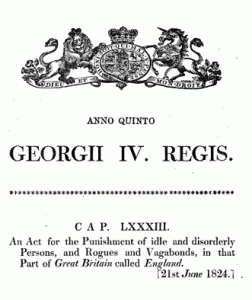 e in vagrancy and begging, the UK government introduced in 1824 the Vagrancy Act, making it an offence to sleep rough or beg in England and Wales, thus criminalising homelessness.
e in vagrancy and begging, the UK government introduced in 1824 the Vagrancy Act, making it an offence to sleep rough or beg in England and Wales, thus criminalising homelessness.
Punishment for begging was imprisonment and up to one month’s hard labour, while sleeping rough carried a higher tariff of up to three months hard labour. Parts of this Act were still in force in England and Wales some 200 years later.
The cost to villages, towns and cities of providing for the poor, known as ‘Poor Relief’, was also increasing significantly. In an attempt to stem the cost, the government introduced the Poor Law Amendment Act in 1834. This Act united groups of parishes into larger and more economical Poor Law Unions. New workhouse accommodation was built in order to reduce, through economies of scale, the amount being paid out to the poor as ‘Outdoor Relief’ such as financial assistance, food, clothing etc. The Guildford Union brought together 21 parishes overseen by a single elected Board of Guardians with the Guildford Union Workhouse opening in Union Lane (now Warren Road) in 1838.
The 1834 legislation, however, had made no specific provision for vagrants, and many workhouses were reluctant to admit them due to their perceived bad influence and possible threat of carrying disease. This led to the Poor Law Commission in 1837 introducing a further regulation requiring workhouses to provide vagrants with one night’s stay in return for doing some work.
Over the years, vagrancy continued to be stigmatised. In 1866, a widely circulated article in the press following a report from the Poor Law Board said of vagrants that ‘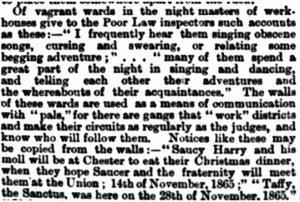 Many of this class are totally reprobate, savage and violent, and like untamed wild beasts’, so it is little wonder that with such rhetoric, they collectively had such a bad name.
Many of this class are totally reprobate, savage and violent, and like untamed wild beasts’, so it is little wonder that with such rhetoric, they collectively had such a bad name.
This article went on to colourfully describe typical behaviour and language of vagrants in the workhouse: ‘I frequently hear them singing obscene songs, cursing and swearing, or relating some begging adventure’.
Henry Simmonds may or may not have been familiar with this type of behaviour, but, assuming the 1881 Census is correct, he was born in one of the worst slums in England. 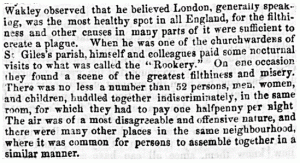 The St Giles area of London is nowadays the tourist and entertainment area of the West End including Covent Garden and Soho. However, it was very different in Henry’s day. When he was growing up, St Giles, known as The Rookery, was massively overcrowded and one of the seediest and most lawless parts of the capital.
The St Giles area of London is nowadays the tourist and entertainment area of the West End including Covent Garden and Soho. However, it was very different in Henry’s day. When he was growing up, St Giles, known as The Rookery, was massively overcrowded and one of the seediest and most lawless parts of the capital.
In the 1840s, the authorities attempted to clear the slums by building the current day New Oxford Street straight through the worst part as a method of ‘decontamination by demolition’. Unfortunately, this made matters worse as it led to further overcrowding in remaining buildings, forcing residents into other nearby slums.
Although we don’t know if Henry did live in St Giles in his early years, any time spent there would surely have affected him. Perhaps he lost his job, his home or both, with vagrancy his only means of survival or escape.
The Casual Ward
In the early workhouse years, vagrants and the destitute poor were accommodated in the same wards, but workhouses soon began to establish separate rooms or ‘casual wards’ to keep the vagrants apart from the longer-term pauper inmates.
In 1855 the Guildford Union Workhouse began to use two basement rooms for casuals, underneath a newly built school and elderly & infirm wards block at the southern edge of the site, with a separate entrance and well away from the main workhouse building.
In 1872, Guildford Union’s first purpose built casual ward, designed by H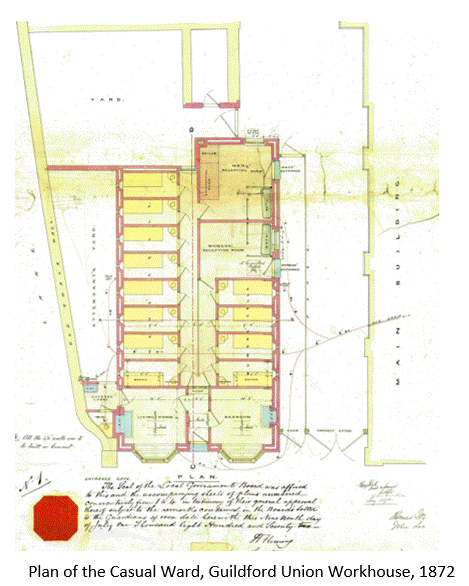 enry Peak, was constructed alongside the main Workhouse.
enry Peak, was constructed alongside the main Workhouse.
This building accommodated up to eight men and four women locked in individual cells at night in order to control behaviour.
Separate entrances for women and men led to reception areas, each containing a room with a single bath. The men’s reception area also had a disinfecting oven and boiler.
Each cell had a bench bed, most probably simple wooden boards, and a commode.
Hard labour was undertaken in the Attendants’ Yard.
This was where Henry Simmonds spent the night of 3rd April 1881.
A stay in the Casual Ward
Clutching a casual ward admission ticket issued by the local police, Henry would have joined a queue of vagrants outside the Guildford Union Workhouse wall in Union Lane (now Warren Road) on that early Spring day, before being let in about 6pm for his one-night stay.
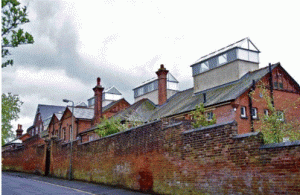 He would have known that on entering, he would be searched, and any money or tobacco confiscated. To avoid this, vagrants who regularly passed through the Guildford Union Workhouse knew of hiding places for their possessions, such as behind loose stones or bricks in the wall outside the workhouse, or in a nearby hedge.
He would have known that on entering, he would be searched, and any money or tobacco confiscated. To avoid this, vagrants who regularly passed through the Guildford Union Workhouse knew of hiding places for their possessions, such as behind loose stones or bricks in the wall outside the workhouse, or in a nearby hedge.
Henry would have handed over his ticket, entered the men’s reception room and registered his details – name, age, occupation, where he had come from and where he was planning to go.
He would have undressed, had his clothes taken away to be fumigated, and been forced to have a bath and a brief medical inspection. Anyone with an infectious disease would have been immediately sent to the emergency or isolation ward.
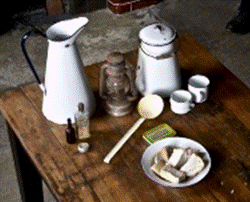 Now clean, Henry would have put on a workhouse nightshirt and been provided with a blanket and supper. This was probably no more than eight ounces (0.23kg) of bread and a pint (0.57 litres) of oatmeal boiled in water, known as gruel or ‘skilly’. He would then have been locked up in his cell from around 7pm to 6 or 7am the next morning. Breakfast for Henry was the same as his supper – bread and gruel.
Now clean, Henry would have put on a workhouse nightshirt and been provided with a blanket and supper. This was probably no more than eight ounces (0.23kg) of bread and a pint (0.57 litres) of oatmeal boiled in water, known as gruel or ‘skilly’. He would then have been locked up in his cell from around 7pm to 6 or 7am the next morning. Breakfast for Henry was the same as his supper – bread and gruel.
Before he could leave Henry would have ‘paid’ for his accommodation, perhaps by breaking stones for use in road building, chopping up old railway sleepers for firewood, or picking oakum. The latter entailed the teasing out of fibres from old ropes for use in padding the joints of wooden ships, a task very hard on the fingers. A pointed tool, or maybe a rusty nail, known as a ‘spike’ would have been used initially to break open the rope into more manageable strands. This is one possibility why the Guildford Union casual ward, and others around the country, were known as ‘The Spike’.
So where would Henry have come from, and where would have been heading to after leaving ‘The Spike’? He was likely to have come from one of the other casual wards nearby, such as Chertsey, Dorking, Epsom, Farnham, Godstone or Hambledon, possibly sleeping rough from time to time although, thanks to the 1824 Vagrancy Act, this was punishable by imprisonment if caught. Many vagrants had a regular route they followed. Henry may have ‘tramped’ solely in Surrey or gone further afield to neighbouring counties such as Hampshire or Sussex, or northwards to London. It is even possible that Henry returned from time to time to his birthplace some thirty miles (50km) away in St Giles.
Life for vagrants like Henry changed slightly with the passing of the Casual Poor Act of 1882 which made it a requirement for casuals to be accommodated in workhouses for two nights rather than one, with the full day in between spent performing tasks. The casuals would then be released at 9am after the second night. Return to the same Workhouse was not allowed within 30 days, with the penalty being four nights detention and three days’ work being performed in between. Those entering a casual ward on a Saturday evening were detained an extra day since no work was performed on a Sunday.
Unfortunately, what happened to Henry after he left Guildford’s ‘Spike’ back in April 1881, age 60, remains a mystery.
Spike Heritage Centre
In 1906, the Guildford Union Workhouse opened a new larger casual ward, designed to accommodate 30 men and six women or women with children.
With the demise of the Workhouse system in 1930, the Workhouse and its infirmary became Warren Road Hospital, and then was re-named St Luke’s Hospital in 1945, becoming part of the new National Health Service in 1948.
The casual ward remained operational as a reception centre until closing permanently in May 1962. The casual ward was given Grade II listed building status in 1999 and is now the Spike Heritage Centre. It is one of a very few Poor Law buildings remaining from that era. Four of the work cells have been preserved including the iron grids through which the broken pieces of stone or chopped wood were dropped by the vagrants into containers on the outside. Some of the cells for accommodation can also be seen, with graffiti written on the inside of the doors still visible.
August 2023, updated January 2024
Sources
Ancestry.co.uk
FindMyPast.co.uk / British Newspaper Archive
CoveCollective.org
General Register Office GRO.gov.uk
GOV.uk, Legislation.gov.uk
LandmarksInLondonHistory.wordpress.com
Surrey History Centre, Woking Surreycc.gov.uk
The Charlotteville Jubilee Trust Ltd, Guildford Charlotteville.co.uk
The National Archives Education Service/Nottingham Trent University VictorianPoor.org
The Guildford Dragon Guildford-Dragon.com
The Spike Heritage Centre GuildfordSpike.co.uk
Wikipedia.co.uk
Workhouses.org.uk
For a full list of references click here.
